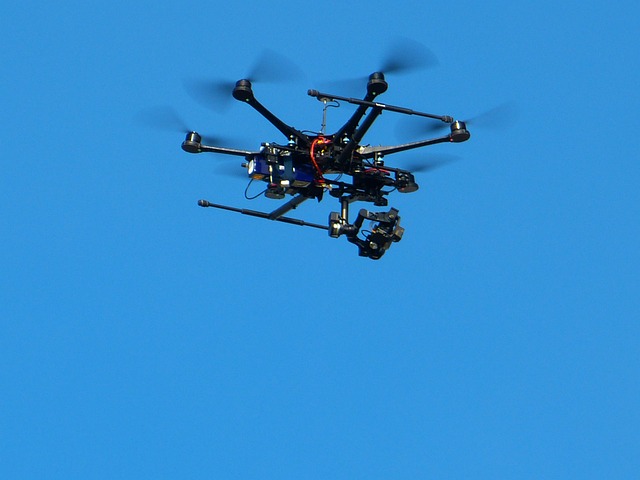Drone-assisted surveillance provides continuous 24/7 remote surveillance with high-resolution cameras and sensors, revolutionizing large-scale monitoring in industries like infrastructure, construction, and events. It offers unparalleled coverage, enhances operational awareness, aids risk management, and reduces incident response times. This technology is crucial for border security, environmental conservation, and infrastructure maintenance, with AI integration expected to further improve data analysis and decision-making speeds.
“Drone-assisted surveillance is transforming large-scale monitoring, offering unprecedented efficiency and coverage. This article explores the multifaceted benefits of drone technology in security applications, focusing on 24/7 remote surveillance. From unlocking operational advantages to tackling challenges, we delve into case studies and future trends shaping this dynamic field. Discover how drones revolutionize protection, ensuring constant vigilance across expansive areas.”
Unlocking Efficiency: Drone Surveillance Benefits
Drone-assisted surveillance offers unprecedented efficiency in large-scale monitoring, enabling continuous and comprehensive observation from the air. This technology provides a significant advantage over traditional methods by offering 24/7 remote surveillance capabilities, allowing authorities to detect and respond to issues promptly. With drones equipped with high-resolution cameras and advanced sensors, every corner of a vast area can be covered, ensuring no detail goes unnoticed.
This method is particularly beneficial for large industrial sites, construction projects, or event venues where extensive area coverage is required. Drone surveillance enhances operational awareness, aids in risk management, and facilitates faster incident response times. Moreover, it allows for cost-effective and efficient data collection, providing real-time insights to support informed decision-making processes.
24/7 Coverage: Advantages and Applications
Drone-assisted surveillance offers unparalleled advantages in terms of 24/7 remote surveillance. Unlike traditional methods restricted by human limitations and schedules, drones can operate continuously, providing uninterrupted coverage over vast areas. This capability is particularly valuable for large-scale monitoring tasks that demand constant vigilance, such as border security, environmental conservation, and infrastructure maintenance.
The applications of non-stop drone surveillance are diverse and far-reaching. In critical infrastructure sectors, drones can patrol power lines, pipelines, and bridges, detecting issues or damage in real time. In environmental conservation efforts, they can monitor wildlife habitats, track deforestation, and surveil endangered species without disturbing their natural behavior. Moreover, this technology enhances security at large events, providing comprehensive aerial coverage to identify potential threats or hazards.
Remote Monitoring: Challenges and Solutions
The rise of drone technology has presented a game-changing solution for 24/7 remote surveillance, addressing challenges faced in large-scale monitoring. Traditional methods often struggle with continuous coverage and accessibility, especially in vast or rugged terrain. Drones overcome these hurdles by providing a persistent aerial perspective, capturing high-resolution imagery and video data that can be transmitted in real-time.
This capability is pivotal for various industries, from environmental conservation to infrastructure management. For instance, drones can monitor forest health, detect illegal logging activities, or inspect hard-to-reach power lines. By leveraging drone-assisted surveillance, organizations can enhance operational efficiency, deter illicit practices, and make informed decisions based on continuous data collection, ultimately leading to better resource allocation and proactive issue resolution.
Enhanced Security: Case Studies and Future Trends
Drone-assisted surveillance is transforming large-scale monitoring by offering unprecedented levels of 24/7 remote surveillance. Case studies have demonstrated its effectiveness in various sectors, from border control and wildlife conservation to infrastructure management and disaster response. For instance, drones equipped with high-resolution cameras and sensors can swiftly identify unauthorized access points, track movement across vast areas, and capture detailed imagery for damage assessment during emergencies.
Looking ahead, future trends hint at more sophisticated drone integration within security systems. Advancements in artificial intelligence will enable automated data analysis, enhancing decision-making speeds and accuracy. Additionally, drones will likely collaborate with ground-based sensors and cameras to create a holistic surveillance network, providing comprehensive coverage and real-time updates. This convergence of technologies promises to elevate security measures to new heights, ensuring safer and more secure environments for communities worldwide.
Drone-assisted surveillance offers a revolutionary approach to 24/7 remote surveillance, enhancing security across various sectors. By leveraging these advanced technologies, organizations can efficiently manage vast areas, ensuring comprehensive protection. Overcoming challenges through innovative solutions paves the way for future trends, making drone surveillance an indispensable tool in the quest for enhanced security and peace of mind.
